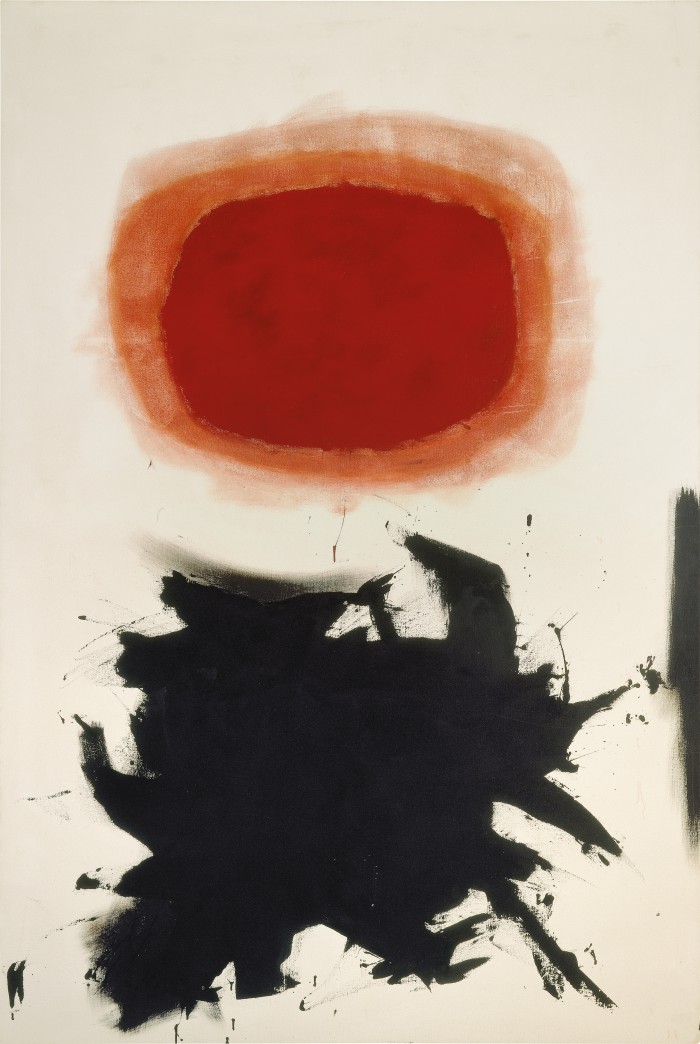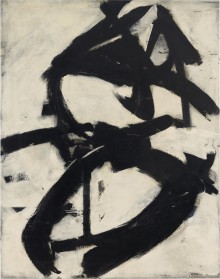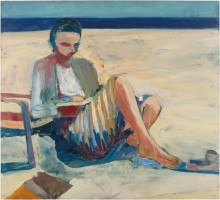Adolph Gottlieb
Transfiguration III 1958

Art © Adolph and Esther Gottlieb Foundation/Licensed by VAGA, New York, NY. Reproduction of this image, including downloading, is prohibited.
Audio Description (01:22)
Full Audio Transcript (Expand)
Transfiguration III
This painting is comprised of two primary elements, an orange-red abstracted sun occupying the top half and a jagged black paint splotch beneath it. Transfiguration III is seven and a half feet tall by five feet wide, the warm white background provides a generous perimeter leaving about two thirds of the space for sun and splotch.
The sun has a large dark orange-red center outlined by an orange corona then a light orange halo. The shape is a wide rounded octagon standing on point. The edges are irregular and smudgy, and there aren’t visible brush strokes as if the paint was applied with a light touch or dabbed on. The outlines each lose a little bit of the octagonal shape and the outermost layer is a wispy rounded rectangle.
The black splotch beneath the sun is a dense mass with roughly a dozen thick brush strokes spiking and curving out in all directions. The center mass can be a right isosceles triangle or a square depending on which protrusions you focus on. Black paint spatter surrounds the shape but the inside of the shape is uninterrupted solid black.
To the right of the black splotch is a blurred vertical brush stroke about two feet long at the edge of the canvas.
Gottlieb’s Transfiguration III expresses a different kind of energy. It is a “burst” painting, a typology Gottlieb conceived in 1957 that juxtaposes two shapes on a vertical axis. Set against a stark background, a haloed red oval hovers above a nest of black brushstrokes. The title alludes to the biblical account of Jesus Christ’s metamorphosis on a mountain, during which his body became radiant with divine light as his disciples looked on from below. Gottlieb conveys the essence of this event through the composition’s contrasting abstract forms.
Prior to the Andersons acquiring Transfiguration III, the work was in the personal collection of William Rubin, who was then Chief Curator of Painting and Sculpture at the Museum of Modern Art in New York.
-Sidney Simon, PhD ‘18
Spirituality and the Ethics of Inspiration
Transfiguration III is one of a series of Adolph Gottlieb’s paintings that critics call his “Burst Paintings”—upright, rectangular canvases on which two different-colored shapes hover one above the other, as though simultaneously attracting and repelling each other. The word “transfiguration” means a change of form. The title connotes Christian biblical tradition and recalls The Transfiguration by Italian Renaissance painter Raphael, which depicts Jesus revealing his divine form and floating above his disciples.
Gottlieb saw the significance of abstract painting as stemming from its content, rather than the technique displayed in the arrangement of lines and shapes. To reach this kind of content, he argued for using what he called “primitive” symbols, which he felt held the origins of human feeling. By “primitive,” Gottlieb meant a return to the ancient Greeks, biblical scripture, and Indigenous art. How does his idea of “primitivism” sit with you? Is it an example of artistic inspiration, appropriation, or maybe even both? Does it gloss over cultural differences or show thought-provoking commonalities?
—Callum Tresnan ‘23







